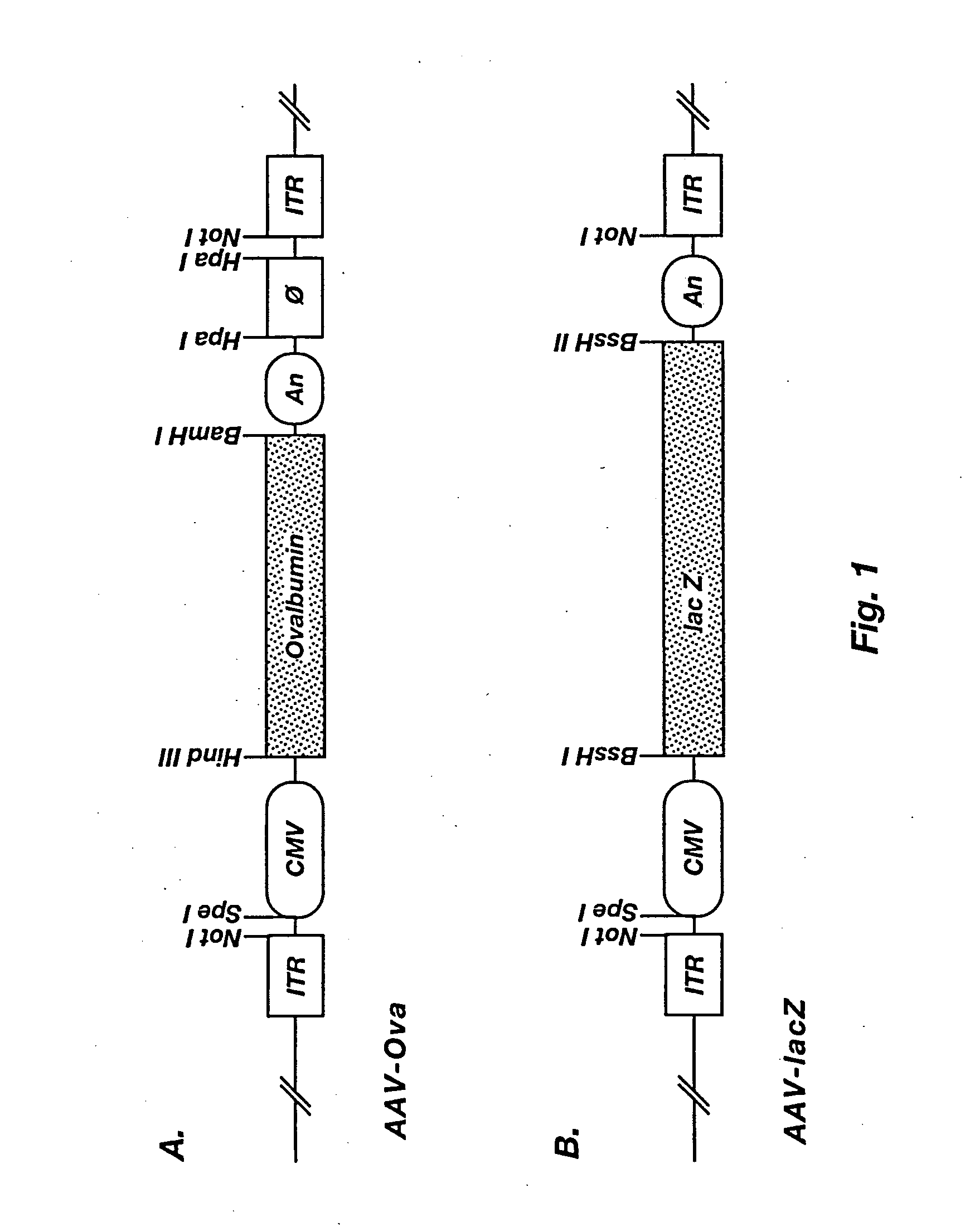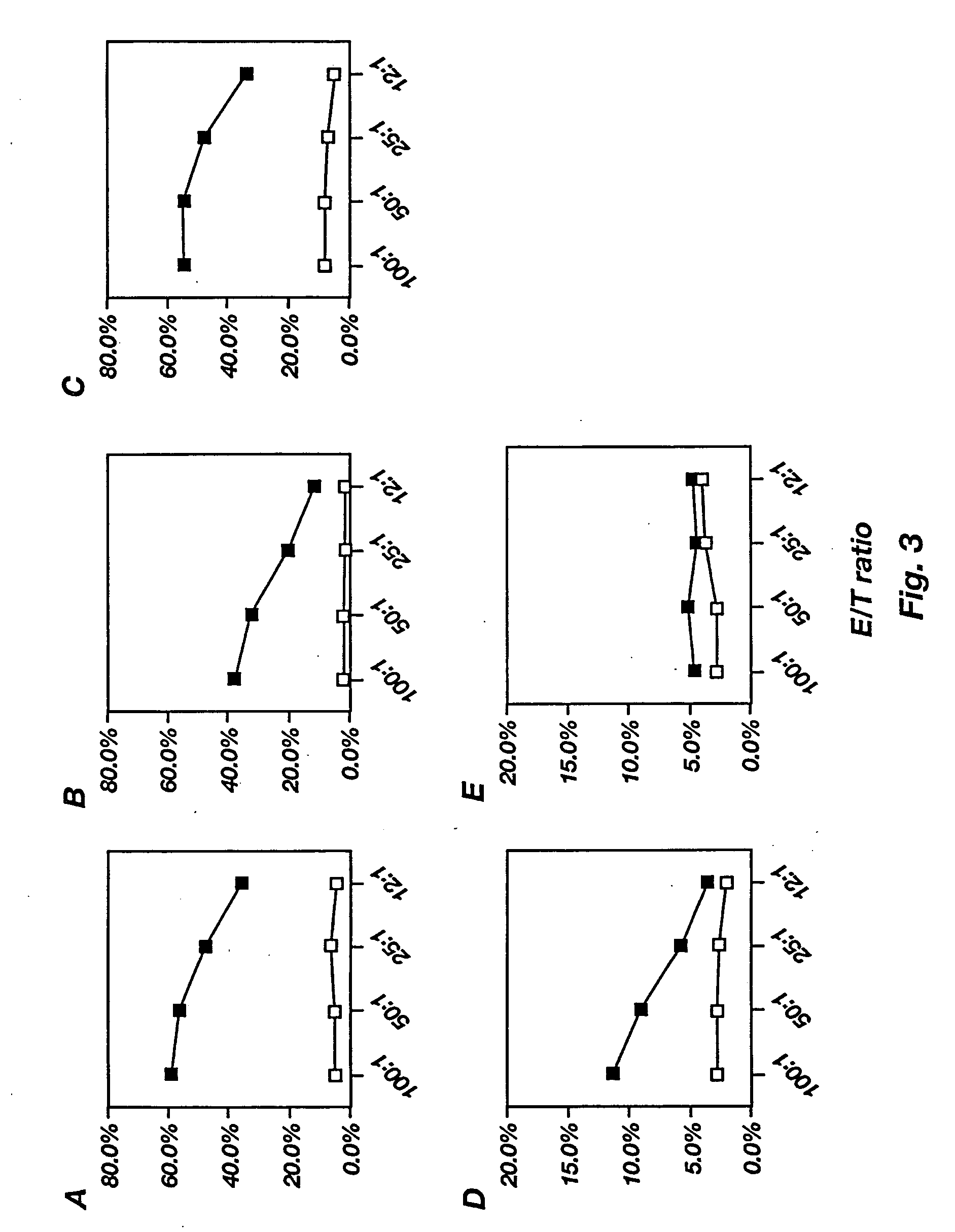Induction of immune response to antigens expressed by recombinant adeno-associated virus
a technology of recombinant adenovirus and immune response, which is applied in the field of induction of immune response to antigens expressed by recombinant adenovirus, can solve the problems of severe disease in immunocompetent hosts, mild or rarely, and the presence of live vaccines that may also contain undesirable components
- Summary
- Abstract
- Description
- Claims
- Application Information
AI Technical Summary
Benefits of technology
Problems solved by technology
Method used
Image
Examples
example 2
In Vivo Protection Study
[0196] To determine if rAAV virions can be used to elicit protective anti-tumor immunity, a tumor model based on the ovalbumin-transfected murine melanoma cell line B16 (MO5 20.10) was used, which expresses a H-2K.sup.b-restricted ovalbumin specific CTL epitope (Falo et al. (1995) Nat. Med., 1:649-653; Condon (1996) Nat. Med., 2:1122-1128).
[0197] C57BL / 6 (n=5) mice were injected once with either 3.times.10.sup.11 rAAV-Ova virions, 3.times.10.sup.11 rAAV-lacZ virions, or DPBS intraperitoneally on day 0. After 14 days, mice were challenged subcutaneously with 1.times.10.sup.5 M05 20.10 cells in the left flank, after which they were monitored daily for the appearance of tumors at the injection site. Tumors>3 mm in diameter were scored positive. Mice with tumors>2 cm in diameter were sacrificed.
1TABLE I Development of Protective Anti-Tumor Immunity Following a Single Injection of AAV-Ova in C57BL / 6 mice Immunization* No. of Tumor-Bearing Mice DPBS 5 / 5 AAV-lacZ 4 / ...
example 3
Ability of rAAV-Ova to Deliver Transgene Product into the MHC Class I Pathway
[0199] Peptides presented in the context of MHC Class I are usually derived from proteins which are expressed endogenously in the cell. Virus-encoded proteins expressed by the cell are typically processed in the cytosol, transported into the ER and presented on the cell surface in association with MHC Class I determinants (Monaco, J. (1992) Immunol. Today 13:173-178; Rock, K. (1995) Immunol. Today 17:131-137). To investigate if rAAV-Ova delivers the transgene product into the class I pathway, irradiated EL-4 cells were co-cultured for 18-24 hours with various doses of rAAV virions (rAAV-Ova or rAAV-lacZ), after which they were tested for the ability to stimulate IL-2 secretion of an MHC class I restricted CD8+ T cell hybridoma B3Z (Karttunen et al. (1992) Proc. Natl. Acad. Sci. USA 89:6020-6024), specific for residues 257-264 of ovalbumin.
[0200] CTL Proliferation Assay: Stimulation of the CD8.sup.+ T cell h...
PUM
| Property | Measurement | Unit |
|---|---|---|
| concentration | aaaaa | aaaaa |
| temperatures | aaaaa | aaaaa |
| pH | aaaaa | aaaaa |
Abstract
Description
Claims
Application Information
 Login to View More
Login to View More - R&D
- Intellectual Property
- Life Sciences
- Materials
- Tech Scout
- Unparalleled Data Quality
- Higher Quality Content
- 60% Fewer Hallucinations
Browse by: Latest US Patents, China's latest patents, Technical Efficacy Thesaurus, Application Domain, Technology Topic, Popular Technical Reports.
© 2025 PatSnap. All rights reserved.Legal|Privacy policy|Modern Slavery Act Transparency Statement|Sitemap|About US| Contact US: help@patsnap.com



